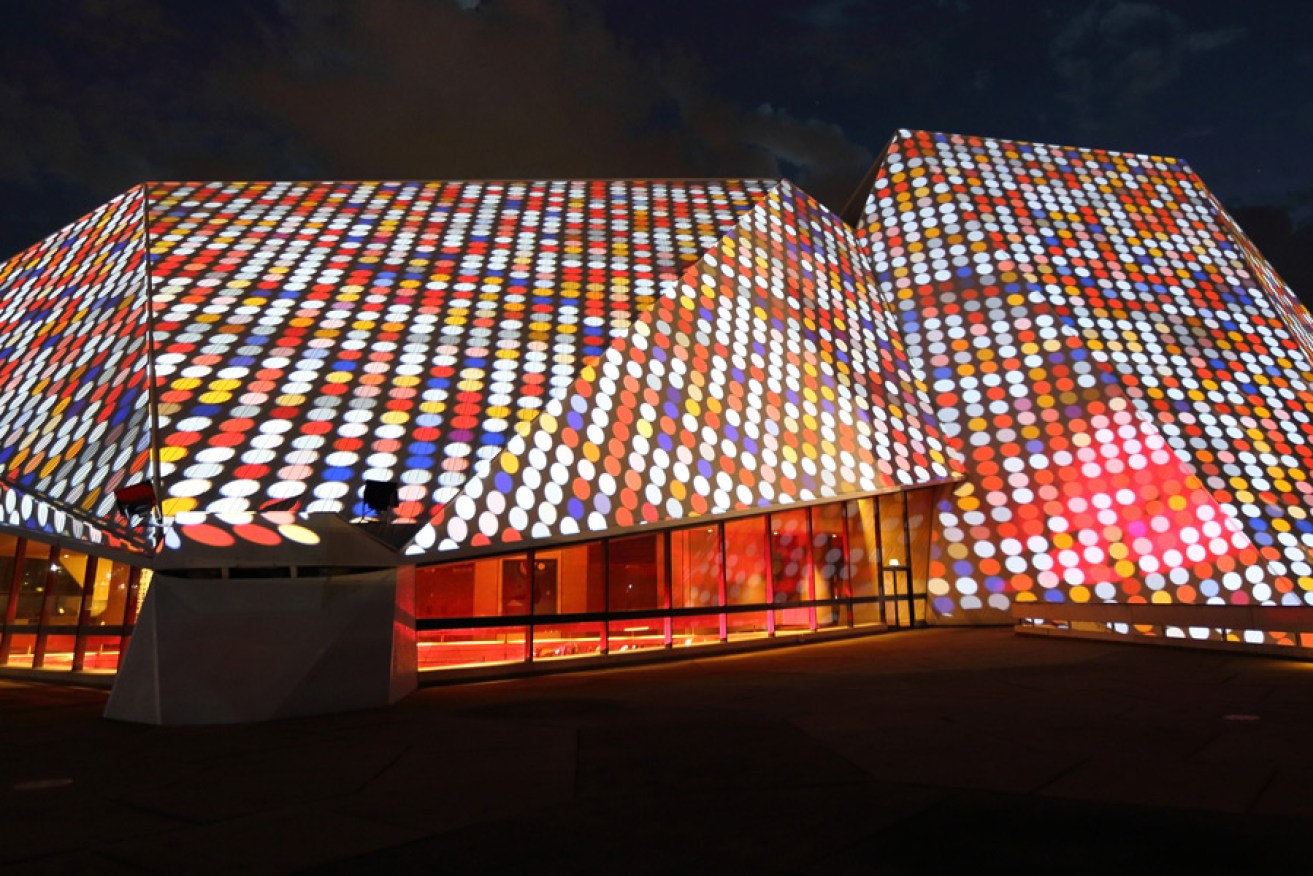Blinc set to light up Adelaide

Dots for Adelaide, by Hartung and Trenz, part of the Blinc light show. Photo: Tony Lewis/Adelaide Festival
The switching on of a spectacular free outdoor light show featuring works ranging from a giant 3D elephant and a digital swarm of bees to a dancing space monkey will herald tonight’s opening of the 2015 Adelaide Festival.
“It’s the most ambitious public event the festival has ever put on,” Festival artistic director David Sefton says of Blinc, which features works by more than 20 international artists.
The installations and projections – displayed in and around Elder Park, the Adelaide Festival Centre and the Torrens Riverbank Precinct – are scheduled to be switched on at 9pm tonight during an opening-night party which begins from 4pm in the park, with a Blinc Bar, Fork on the Road food trucks and fireworks.
British artist and Blinc co-curator Craig Morrison says Blinc will effectively turn the outside public space into a free public gallery.
“One of the things that I really like about this is that when people come down and see it, there will be things that they have never seen before. As an artist, you are giving the viewer something completely different.
“It’s effectively like opening a gallery to the public and not having walls on it … you can do anything with it.
“The only limits are your imagination.”
There is certainly plenty of imagination at play with the more than 30 digital artworks in Blinc, which utilise technology such as 3D motion graphics, LED and laser lighting, mapped projection and animation.
One of the installations likely to prove especially popular is Elephantastic, created by Topla Design of France, which uses CGI technology to create a giant 3D elephant from light in Elder Park.
Works commissioned especially for the Adelaide Festival include Swarm, by artist Wendy Dawson (UK), which will see the Festival Theatre roof covered in a digital swarm of honey bees; Morrison’s own work Retina, which will see the façade of Parliament House transformed into a wall of blinking eyes, and Taxonomy, by Sean Vicary (UK), an animation on the northern façade of 2 King William Street which will transport viewers to the inside of a museum showcase.
Around half of the works incorporate music or sound effects. Some are also interactive, such as Submergence, by Squidsoup (UK/NZ), an LED light installation in the Elder Park Rotunda which people can walk inside, and Murmur (France), which will be located near the Blinc Bar and will turn visitors’ voices into light waves.
Morrison, who is also co-founder of Blinc in Conwy, North Wales, says his brief was to select a diverse group of artists who were creating interesting work that was not commercially driven.
He found that the Adelaide Festival’s reputation helped him to sign up some of the most respected artists in the field, including Squidsoup, Topla Design, Laszio Zsolt Bordos (Hungary) and Dawn of Man (US). Other artists are from Australia, Japan, the Netherlands, Denmark, Norway and Germany.

A-Synchron, by Laszio Zsolt Bordos, is a piece of 3D mapping projected onto the Festival Theatre roof and Parliament House façade. Photo: Tony Lewis
“It’s a bit like a group show and a snapshot of things that have happened in this field and best practice in the genre,” Morrison says. “It’s quite unique.
“Everybody on that list is very, very good at what they do.”
Morrison was recently involved in a large-scale World War I commemorative project in the UK, and his second work in Blinc continues that theme. Requiem, on the River Torrens, will be a tribute to the soldiers involved in the Gallipoli campaign, with a sequence of gold beams spelling out thank-you in Morse Code.
While his own design experience spans everything from film and theatre design to an award-winning range of accessories, he says one of the attractions of a project like Blinc is that it reaches people who may not ordinarily visit a gallery to view art.
“As an artist you can show people something that is very unique, and do it in the open air without people having any preconceptions.”
“It’s exciting because it’s hard in the modern age to introduce people to something new … they [the Blinc works] are a collective experience which hopefully will be positively received and which will inspire people.”
Blinc is free and will continue for the duration of the Adelaide Festival (until March 15), with show times from 8.30pm until midnight Sunday to Thursday, and from 8.30pm until 1am on Fridays and Saturdays.
Click here for more 2015 Adelaide Festival stories and reviews.






